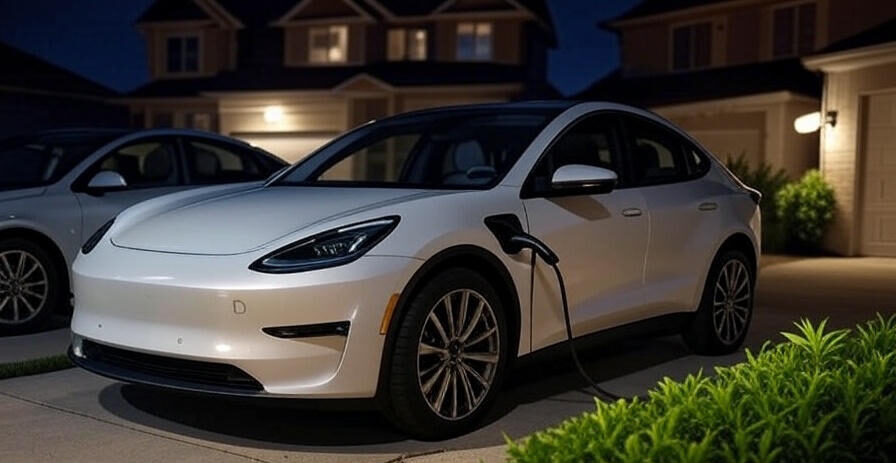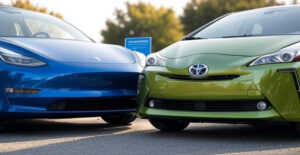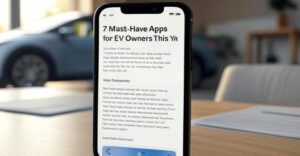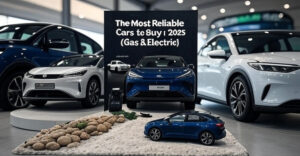Alright, so you finally ditched that old gas-guzzler and jumped on the electric bandwagon — congrats! But now you’re standin’ in your driveway thinkin’, “How the heck do I charge this thing without turnin’ my garage into Frankenstein’s lab?” Relax, buddy. Home EV charging in 2025 is easier, faster, and more affordable than ever.
In this down-to-earth guide, I’ll break down exactly how to charge your electric ride at home, what it really costs (hint: less than your daily latte habit), the best charger options, smart install tips, and how to make your setup future-proof. I’ll even answer 10-12 juicy questions at the end because I know you’ve got ‘em.
So grab a coffee, plug in (pun intended), and let’s get your garage ready for the EV life.
Why Home Charging is a Game-Changer in 2025
Picture this: no more late-night gas station runs, no more waitin’ in line when your tank’s on E, no more spikin’ gas prices ruinin’ your road trips. With home EV charging, your car charges while you binge Netflix or snore through a Sunday nap.
In 2025, EV batteries hold more juice and chargers are faster than ever. Most people who own an EV do 70-90% of their charging at home. It’s kinda like havin’ your own private gas station — minus the stale coffee and weird hot dogs.
The 3 Ways to Charge Your EV at Home
Let’s break down your options, from the “I-just-bought-an-EV-and-I’m-broke” method to the “I-want-F1-pit-stop-speeds” upgrade.
1. Level 1 Charging: The OG Extension Cord
This is the slowest but simplest way. You plug your car straight into a regular ol’ 120V outlet — the same kind you’d use for a toaster.
Pros:
- Dirt cheap — you already have outlets
- No install needed
Cons:
- Slow as a snail. Adds ~3-5 miles of range per hour. Good if you drive like 20 miles a day.
Real life:
If you’ve got a plug-in hybrid like a Prius Prime or a short commute, Level 1 might be fine. But for a full EV, it’s basically a backup plan.
2. Level 2 Charging: The Sweet Spot
This is where most EV owners end up. It’s a 240V outlet — the kind you’d use for your dryer — paired with a dedicated Level 2 charger.
Pros:
- Adds 20-40 miles of range per hour — a full charge overnight
- Tons of smart features available (like scheduling and monitoring)
Cons:
- You’ll probably need an electrician to install the outlet
- Costs some upfront cash
Real life:
Most brands (Tesla, Ford, Rivian, Hyundai, you name it) sell their own wall chargers. Third-party options like ChargePoint, JuiceBox, and Wallbox are big in 2025 too.
3. Level 3 DC Fast Charging: Not for Your Garage
Here’s the thing — DC fast chargers are for public stations, not home. They need special high-voltage hardware that’d basically blow your house’s circuits to Mars. So don’t sweat it. Home = Level 1 or Level 2.
What Does It Cost to Charge an EV at Home in 2025?
Alright, the million-dollar question — or should I say the few cents per mile question. Let’s break it down:
Installation Costs
- Level 1: Nada. Just plug it in.
- Level 2: Plan $500-$800 for a good home charger. Add another $300-$1,200 for an electrician, depending on your panel’s age and how far your garage is from the breaker box.
Pro Tip: Some states, power companies, or car makers offer rebates on chargers and install costs. So check your local utility incentives — don’t leave free money on the table.
Monthly Electricity Costs
The actual cost depends on your electricity rate. Average U.S. residential rate in 2025 is about 15-18 cents per kWh.
Example:
- Let’s say your EV has a 77 kWh battery (like a Ford Mustang Mach-E).
- Charging from 0 to full costs about $12-$14.
- If you do that 4 times a month? ~$50 for 1,000 miles.
Compare that to $150+ in gas for the same miles. Boom — savings in your pocket.
Where Should You Install Your Home Charger?
Placement matters. Think about:
✅ Garage? Ideal — safe, weatherproof.
✅ Driveway? Fine, but get a weather-rated unit.
✅ Carport? Ditto.
Make sure the charging cable actually reaches your car’s port without doin’ a limbo dance every night. Most cables are 18-25 feet, but measure first!
Tips for Choosing the Best Home Charger
2025’s chargers come with all kinds of bells and whistles. Here’s what you really need:
Smart Features
Look for Wi-Fi or Bluetooth — that lets you:
- Schedule charging when rates are cheapest
- Monitor energy use in an app
- Get alerts if there’s an issue

Amperage
Most Level 2 units run 30-50 amps. More amps = faster charge, IF your car can handle it. Example: A Tesla Model 3 caps at 48 amps.
Plug-In vs. Hardwired
Plug-in units connect to a NEMA 14-50 outlet (like a big RV plug). Handy if you ever wanna move it.
Hardwired is tidier, but more permanent.
Should You Go Solar Too?
Thinking of solar panels to charge your EV? 2025’s the golden age for it. Pairing solar + EV charger means you’re makin’ your own ‘fuel.’ Plus, many chargers now sync directly with solar systems to charge when your panels crank out extra juice.
Home Charging Etiquette (Yes, That’s a Thing)
Don’t run extension cords across the sidewalk — it’s a trip hazard and looks tacky. Keep cables coiled tidy so you don’t pull a Tom & Jerry move trippin’ in the dark. And teach your kids the charger ain’t a toy.
How to Future-Proof Your Setup
Thinking ahead is smart. Here’s how to keep your charger useful even if you upgrade your car:
- Overwire: Have your electrician wire for 50 amps even if your charger only uses 30. Future EVs will charge faster.
- Smart Charger: Buy one that can get software updates.
- Universal Plug: Make sure it’s J1772 compatible (the standard for U.S. non-Tesla EVs). Tesla adapters are easy to add later.
Real-World Example: Alex’s Install
My buddy Alex bought a Rivian R1S last year and got a Level 2 charger installed. Cost him $650 for the unit, $900 for the install ‘cause his old panel needed a new breaker. He charges overnight, pays about $40 extra on his electric bill monthly, and laughs every time he passes a gas station. Zero regrets.
10-12 Common Q&A: EV Charging at Home 2025
1. Is Level 1 charging really that bad?
Not if you barely drive! Plug-in hybrids or short commutes? It’s fine. Otherwise, you’ll be waiting forever for a full charge.
2. Do I need a permit to install a home charger?
Most cities do want a permit for 240V work. Don’t skip it — if something sparks up later, your insurance might bail if you didn’t follow code.
3. How long does a Level 2 install take?
Usually 2-4 hours if your panel’s close. More if they gotta run wire across the house.
4. Can I install it myself?
Technically? Maybe. Should you? Heck no. High-voltage DIY can get real ugly.
5. How much does charging overnight cost?
Depends on your car and rates, but $10-$20 for a full charge is normal. Way cheaper than fillin’ up with gas.
6. What if I live in an apartment?
Tricky but not impossible! Many apartments are adding shared chargers. Or look for portable options and negotiate with your landlord.
7. Will my charger work if I switch EV brands?
Yep! Most use the same J1772 plug. Tesla just needs an adapter, which they provide.
8. Is there any tax credit for home chargers?
In many states, yes! Plus federal credits come and go, so check IRS EV credits.
9. Does weather affect charging?
Kinda. Extreme cold slows battery charge speeds a bit. Keep your car plugged in when it’s freezing to warm the battery.
10. Can I plug in every night?
Totally. Modern batteries don’t get memory loss. Just don’t leave it at 100% forever — set it to charge to 80-90% daily if possible.
11. Should I get a smart charger?
If you like saving money and nerdin’ out on energy stats? Absolutely. You can schedule cheaper overnight rates and track usage.
12. How soon will I get my money back?
Depends on gas prices and how much you drive. Most folks recoup the charger cost in a year or so thanks to fuel savings.
.









